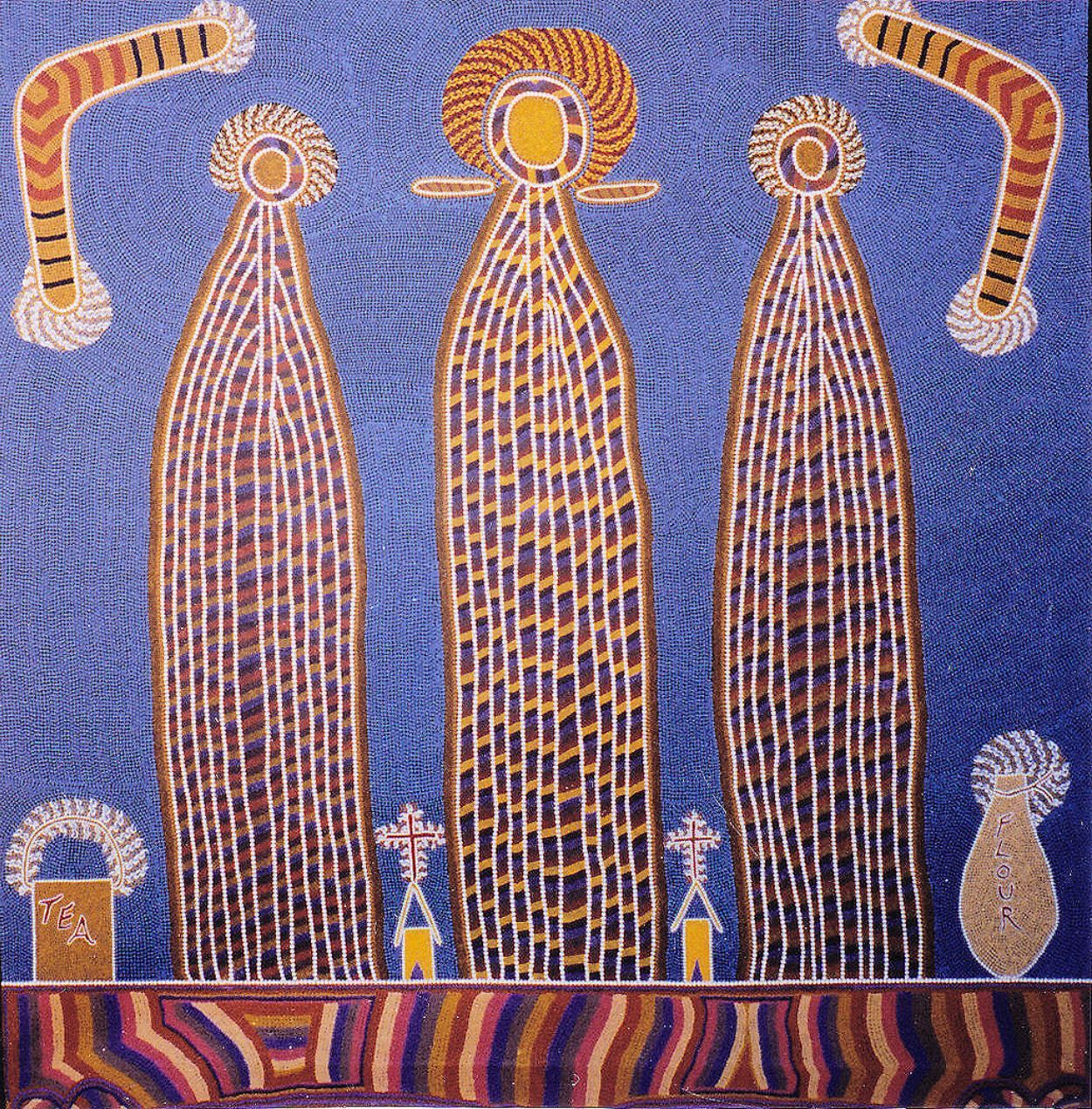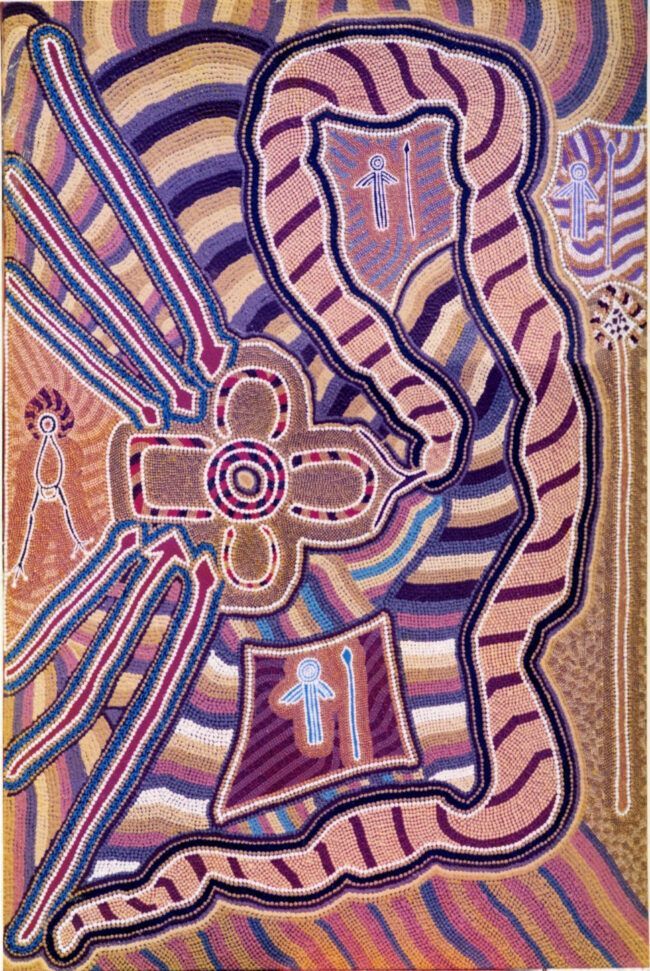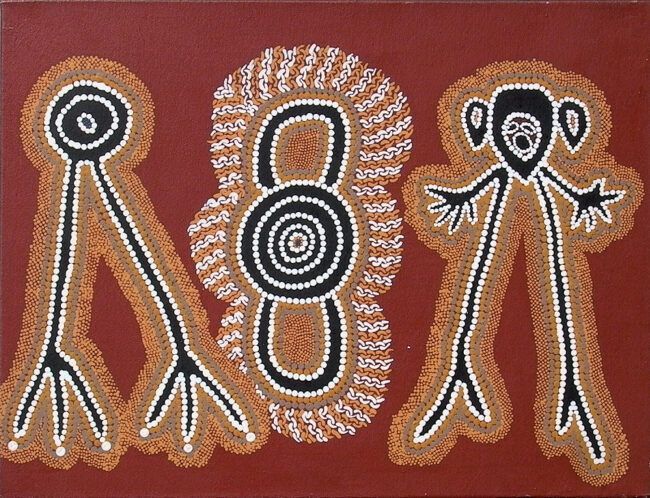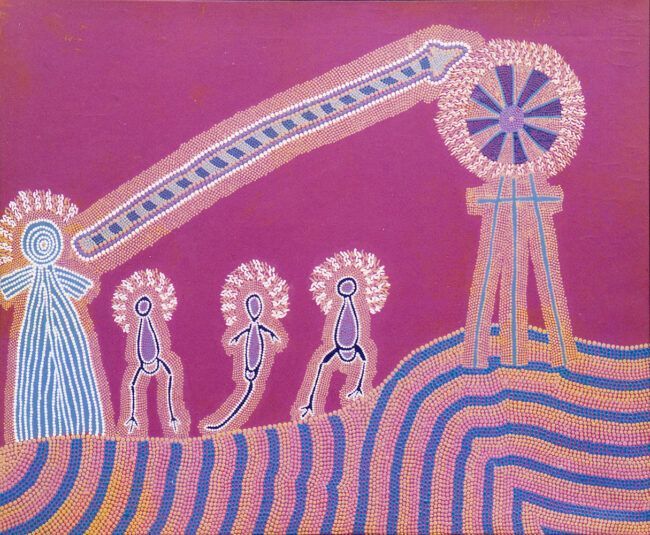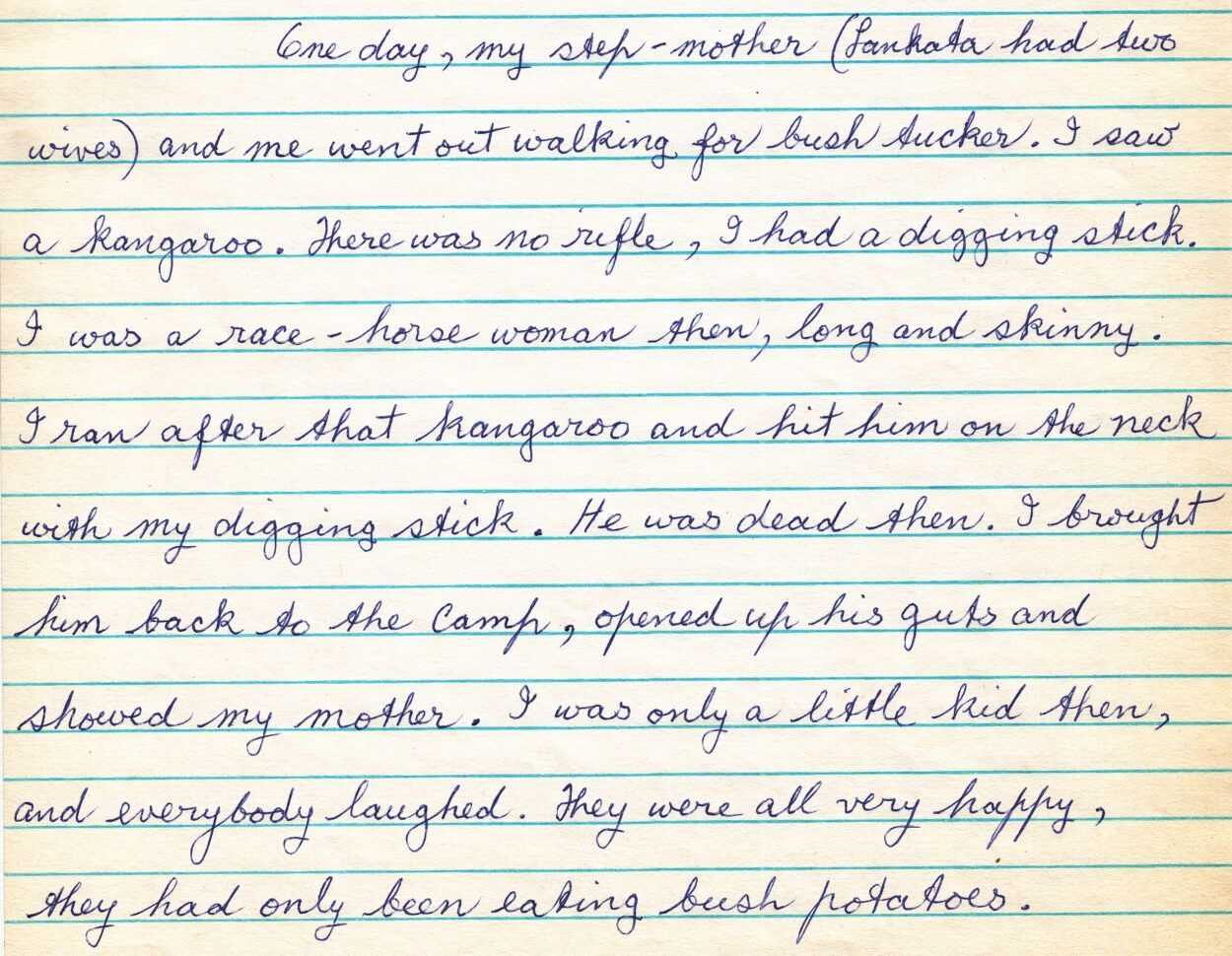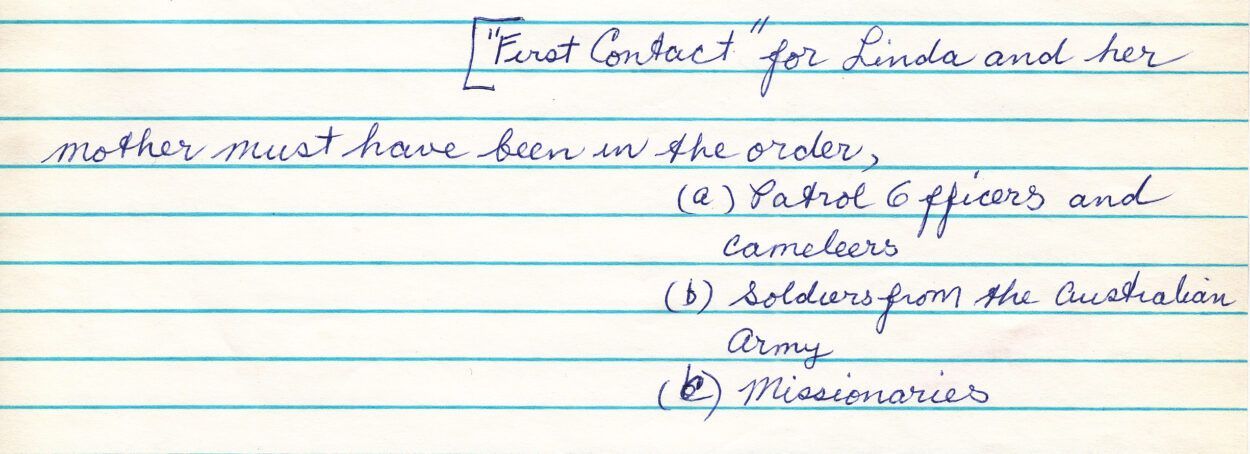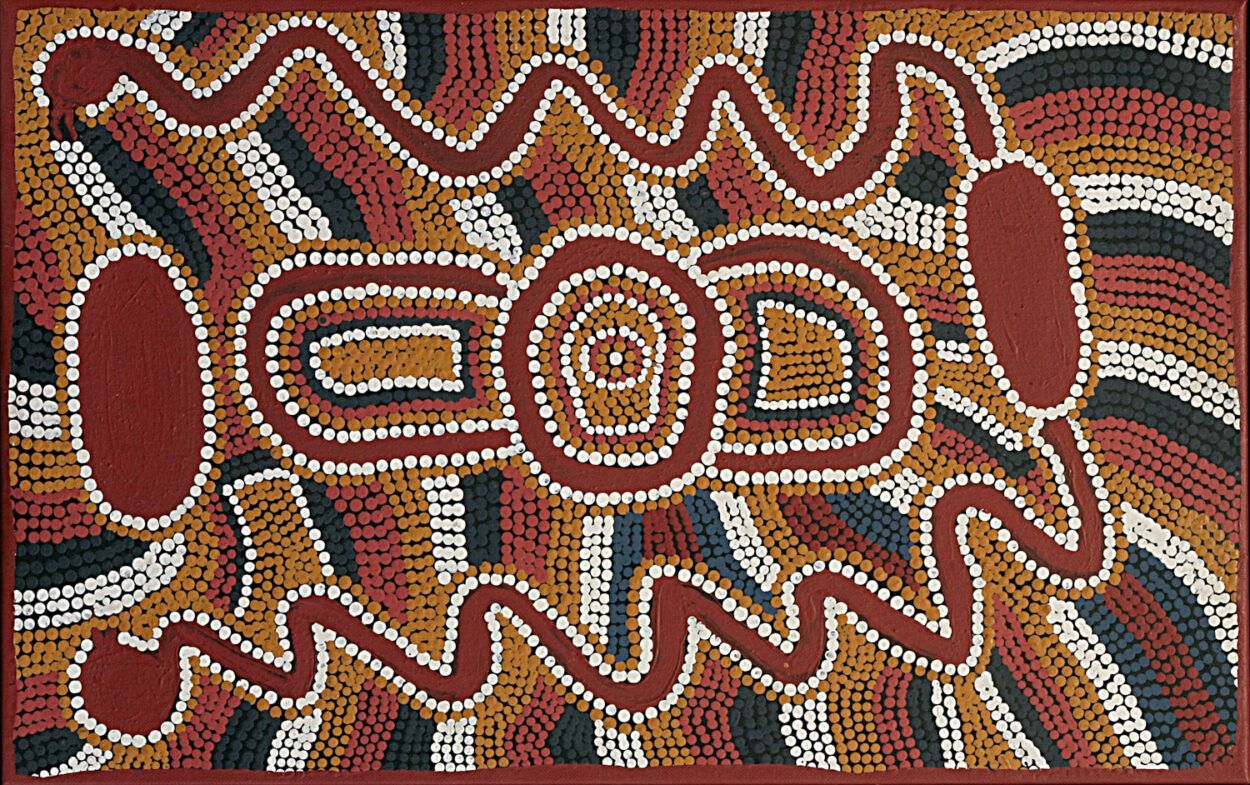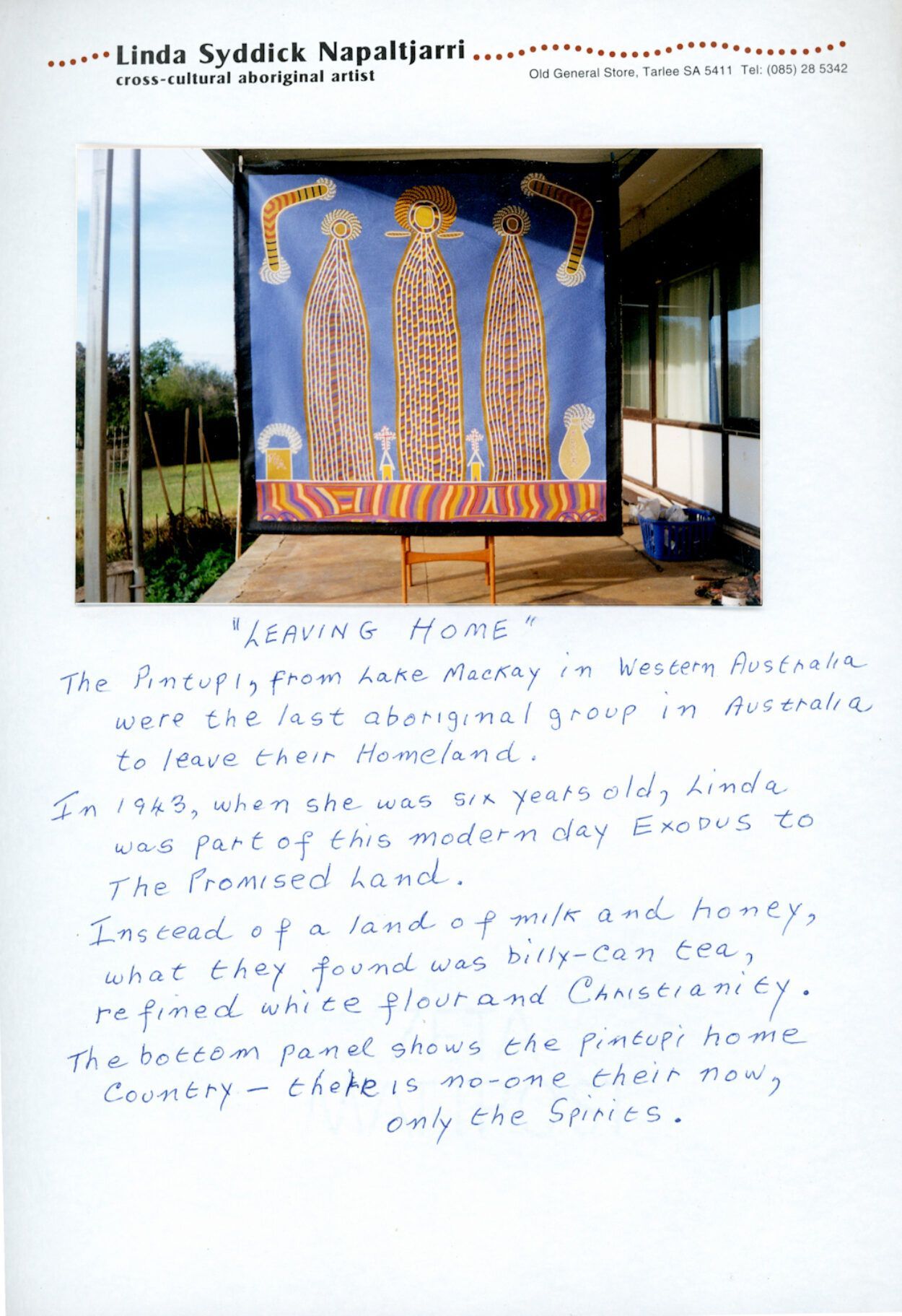Continuing our journey into the extraordinary world created by Linda Syddick Napaltjarri with extracts by her partner Russell Sim.
Chapter 4: An introduction to Tjungkiya Wukup
Much of the following is from the handwritten notes of Russell Sim who recorded his partner Linda Syddick’s story (that have been in the archives of Gallery Gondwana): Tjungkiya Wukup (Linda Syddick) was born about circa 1937, at Lake Mackay in the Gibson Desert of the ‘Western Desert’ region. Lake Mackay is a large salt lake which straddles what is now the Western Australian and Northern Territory border. The lake is about 700 km north-west of Alice Springs.
Leaving Home by Linda Syddick - this paintings with the tea on the left and the flour on the right, and the influence of Christianity merged with Linda's aboriginal culture and beliefs.
The Pintupi people occupied a large area of land, extending hundreds of kilometres in all directions from Lake Mackay. At the time of Linda’s birth, the Pintupi people had minimal contact with white people and had not yet moved away to settlements and missions. They were still living the nomadic life of their ancestors who had occupied this land for thousands of years.
Linda’s mother was Wanala Nangala, a young woman, and her father was Rintje Tjungurrayi, a young Pitjantjatjara man. Linda was their first child. They named her Tjunkiya Wukula Napaltjarri. This was done according to aboriginal law and tradition. The first name was given by the grandmother, the second by consensus of opinion amongst the women whilst the last is the hereditary kinship name which applied to the child.
In many of Linda’s early works, she would often paint her step-father into paintings, as the Emu (his spirit) into the dreaming as seen in this example of Emu and Kunia Ancestors at Lake Mackey. Painted in 1995, we can clearly see the influence of Christianity, with the ancestors in an almost angel-like cross depiction. The melding of cultures.
There are a number of early small works by Linda that depicted just her father as the emu, and even separately and together, Linda’s second father as the kangaroo, as well as depicting both as the emu. In other paintings you see both fathers as the classic ‘U’ shape around a rockhole and next to them are the ancestral spirits of an emu and a kangaroo.
The following story is passed to us in Russell’s handwriting as told by Linda… it reveals an insight to her life as it was for Linda, back then, recollections of a life lived.
We (my mother and stepfather, me, my sister Wentje and little brother Donald, and two aunties) were camped in the desert. We walked a long, long way, to Warburton (in Western Australia). We went up and down, up and down all the way, over sandhills (vegetated hills in rows, typical of the country in the Pintupi Homelands).
We then turned back, and it was up and down, up and down again. We came to Moyen, which is near Kiwirrkura (in Western Australia). At Moyen, we saw a white man with camels (may have been an Afghan camel driver). He had salt meat in a bag.
That man died later on, at a mountain near Docker River (in the Petermann Ranges, near Ayers Rock, NT).
We came to the Kintore area again and stopped where Ronnie Tjampitjinpa was camped with his family at Marlprie (? probably where Ronnie’s outstation is now). Ronnie would have been a little boy then, a few years younger than Linda, who was about six or seven years old. We were eating plenty of bush-tucker there. Bush potato, bush apple, bush plum (little back seeds, like raisins).
We then did more slow walking, up and down again. We had dingo dog meat, but only my mother ate it, us kids didn’t eat it.
My step-father Lungkarta went off hunting and he told my mother to look after us kids. It was hot weather time now, we made a wiltje out of tree branches and sat in it. We walked around, getting bush potatoes. We ate a lot of food that afternoon. About 5 o’clock I said to my mother, “I want to see my Dad”. She said “Daddy over there”. He came back crippled, with no water. A pankalang (evil spirit-being) had been trying to eat him. He had a big kangaroo on his head, but my mother said “Leave that kuka” and the pankalang took the kuka away. There still are a lot of Pankalang near Kintore, also Kadaitcha people.
He then went slow-way walking again, towards Ilpili (halfway between Kintore and Mt Liebig). We were eating porcupine, wyota, pussy-cat, little brown lizard and Kunyia (yellow snake).
We arrived at the old aerodrome at Ilpili. We sat down for a long time there, now. My step-father told my mother “Bring all the kids close here”. We made a wiltje out of tree branches and sat in it. Then, my step-father made rain for us, by throwing his spear high into the sky, same as the Tingari men did when they made rain for the thirsty emus. Both my father Rintje and step-father Lungkarta were Emu Men. A big rain came then, and we sheltered in the wiltje.
We saw an army Toyota at Ilpili, and we saw two missionaries, one of whom was Pastor Albrecht.
We stayed a long time there, at Ilpili. There were two widow-women, my two mothers, me, my sister Wentje, my brother Donald and my baby sister Pamela (born during their journey). It was a boggy place at Ilpili (fine, loose sand, difficult to walk on).
One day, my step-mother (Lungkarta had two wives) and me went out walking for bush tucker. I saw a kangaroo. There was no rifle, I had a digging stick. I was a race-horse woman then, long and skinny. I ran after that kangaroo and hit him on the neck with my digging stick. He was dead then. I brought him back to the camp, opened up his guts and showed my mother. I was only a little kid then, and everybody laughed. They were all very happy, they had only been eating bush potatoes.
We were waiting for Rubini’s husband and step-mother. (Rubini’s father was old Toba, Turkey Tolson’s father, and he had two wives). The step-mother’s name was Wentje, same name as my sister.
Us kids were playing the desert sand. Mum said “Go and meet your dad, he is coming close. My step-father arrived, with my grand father, Turkey Tolson’s father, old Toba Tjakamarra. They came with donkey, horses and camels. Old Toba had been skinning dingo dogs and selling dingo skins. He used a pulinka (stone knife) to skin the dingoes.
They brought a lot of things with them which we had never seen before, this was the first time. There were two bags (100 lb) of white flour, a carton of sugar, a big bag of tea leaves, jam, strong butter and powered milk. Clothes too. We stayed a long time there, then, at llpili.
My old uncle travelled right back to where we had come from, his family were there. He went to Wilpya (?) near Moyen, then he turned back again.
My step-father went with the army mob, in trucks. He said to us, “You all stay here”. So, we stayed there until my step-father came back. When he came back, he looked different. He looked like a cowboy. Boots, trousers and cowboy hat (probably army gear, given to him by soldiers). He had some other people with him. They were my uncle, Nosepeg Tjupurrurla, Charlie Watame Tjungurrayi, Andrew Spencer’s (police aide in Alice) father, Tjungurrayi, step-father(?) Sammy Tjungurrayi.
The soldiers were shooting guns, doing training.
My step-father threw a boomerang and hit a soldier with it. The soldier pretended to shoot my step-father with a gun. My uncle went to help his cousin (my step-father) with a womera and spear. We all laughed about this.
From Ilpili, we went on horses and donkeys to Haast’s Bluff. This was a Lutheran Mission. We were given tea, flour and sugar there. I went to the mission school and learned about Jesus.
I am now happy to be an aboriginal and also happy to be a Lutheran.
Russell was to write that:
“First contact” for Linda and her mother must have been:
(a) Patrol Officers and cameleers
(b) Soldiers from the Australian Army
(c) Missionaries
Ancestral Snakes At Lake Mackay, 1990 by Linda Syddick (Cat 0529LS)
The Windmill
In this rather extraordinary painting, Linda captures an historic moment in time. It was 1948, the year that Linda and her family walked out of the Gibson Desert, leaving behind a way of life their ancestors had lived for thousands of years.
At a remote location, some distance east of Mt Liebig (an Aboriginal community due west of Papunya in Central Australia), Linda and her family (symbolised by the Emu and Kangaroo ancestors) were travelling through the bush on route to Ilpilyi, when all of a sudden they were greeted by a windmill in motion. Such an object had never been seen before and hence was viewed with enormous suspicion and fear, prompting a member of the family (a Tingari Man - represented by the scarecrow-like image to the left hand side of the painting) to spear this ‘evil invader’.
The alternate bands of colour to the base of the painting, depict the vast parallel sand dunes that shape the natural contours of the surrounding countryside.
In 1985, just before Shorty Lungkarta died, he told Linda that she was to carry on his work and to continue to paint his Tjukurrpa (Dreamings). So in 1986, Linda Syddick (Tjangkiya) Napaltjarri was taught to paint by her two uncles Uta Uta Tjangala and Nosepeg Tjupurrula, both of whom were significant figures in the Papunya Desert Art Movement.
When Linda started paint in earnest in 1987, she was 50 years old.
The Pintupi, from lake Mackay in Western Australia were the last aboriginal group in Australia to leave their Homeland.
In 1943,when she was six years old, Linda was part of this modern day Exodus to The Promised Land.
Instead of a land of milk and honey, what they found was billy-can tea, refined white flour and Christianity. The bottom panel shows the Pintupi home Country - there is no-one there now, only the Spirits.

